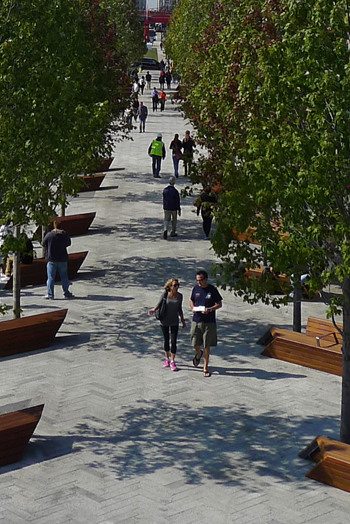IN CHICAGO, NEW PARKS ARE CIVIC INFRASTRUCTURE
For Daniel Burnham, the Chicago architect and planner who created the 1909 Plan of Chicago, civic and infrastructural improvements in Chicago could only happen simultaneously. This approach continues today. Using Burnham’s plan as launching point to discuss some of the parks and landscapes recently created, Marshall Brown, Illinois Institute of Technology (IIT) and Marshall Brown Projects, moderated a panel at the ASLA 2015 Annual Meeting in Chicago with Sarah Astheimer, ASLA, James Corner Field Operations; Matthew Bird, ASLA, Michael Van Valkenburg Associates (MVVA); and Gina Ford, ASLA, Sasaki Associates.
In the Plan of Chicago, Burnham’s approach was an “integration of landscape and architecture,” creating hybrid places that are infrastructural in nature. The three new Chicago parks and landscapes discussed in the session – Navy Pier Pierscape by James Corner Field Operations, Maggie Daley Park by MVVA, and the Chicago Riverwalk by Sasaki – are also hybrids. All three designs required a high level of performance, a “new contemporary green and sustainable design,” as Astheimer put it.
Ford called Chicago a “uniquely infrastructural city” and the projects reflect this. The Navy Pier, built in 1916, has a direct line to Burnham’s Plan, as it is the only pier he proposed that was actually created. The new Pierscape reoriented the entrance to the pier, opening a “free and clear view of the lake” as you approach pier, while also attempting to change the perception that pier is disconnected from Chicago and too commercial.
The two other landscapes required building significant new infrastructure:
Maggie Daley Park required construction of a large park filled with activities, but also a naturalistic garden, all built over a parking garage. For MVVA, this meant unifying “a complex site through topography” and an “integration of ideas and programs” to create a landscape to be enjoyed year round, providing opportunities for both play and relaxation.
The Riverwalk required that land literally be built on the river. For Ford, “creating a landscape on water” in a tight space still being used commercially presented a unique set of challenges. By “knitting together” the existing walkways to create a continuous path, as well as creating new places for gathering, socializing, and recreation, the Riverwalk “allows the life of the city and the life of the river to interact.”
All the landscape architects said the creation of interesting public spaces can “get people out of their homes and into their community,” as Bird said. And while landscape architects and designers might not be able to change the world in as broad strokes as they may like, they can at least, as Ford put it, “create a comfortable bench for different people to engage with each other, to have a conversation they might not normally have.” It’s clear that since the days of Burnham, Chicago only continues to build on its legacy of creating and supporting large-scale civic and infrastructural improvements.











Follow Us!